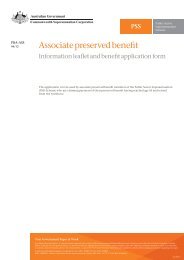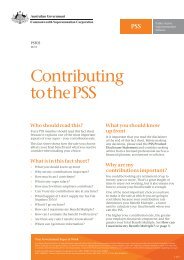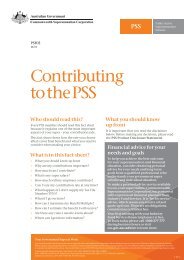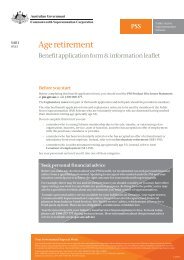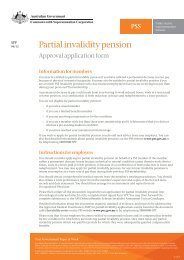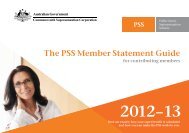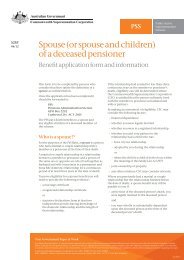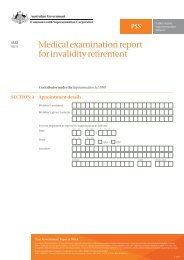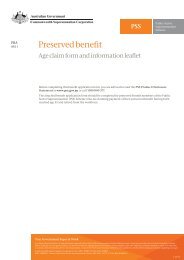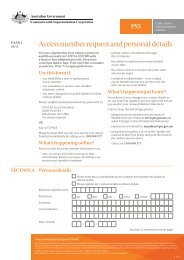Product Disclosure Statement - PSS
Product Disclosure Statement - PSS
Product Disclosure Statement - PSS
You also want an ePaper? Increase the reach of your titles
YUMPU automatically turns print PDFs into web optimized ePapers that Google loves.
2. How super works<br />
Superannuation (super) is a long-term way to contribute<br />
for your retirement which is, in part, compulsory and<br />
most people have the right to choose into which fund<br />
their employer should direct their superannuation<br />
guarantee contributions.<br />
Putting money into your super<br />
Only contributing members can put money into their<br />
super or receive employer contributions. The benefit<br />
provided to contributing members of the <strong>PSS</strong> is defined by<br />
the Final Average Salary and an Accrued Benefit Multiple.<br />
In the <strong>PSS</strong> your employer makes contributions in two<br />
different ways:<br />
1. a fortnightly contribution—the productivity<br />
component, and<br />
2. an employer component that is calculated when you<br />
leave the <strong>PSS</strong>.<br />
Contributing members can choose to make no<br />
contributions or to contribute any whole percentage rate<br />
between 2% and 10% of their fortnightly ‘super salary’.<br />
Contribution rates can be changed at any time to suit<br />
your financial needs.<br />
The amount you contribute affects your benefit. If you<br />
elect to make no contributions your employer-financed<br />
component will accrue at a reduced rate during the<br />
period you are not contributing. As a result, this will<br />
reduce any future benefits that might be payable.<br />
Member contributions, post 1 July 1990 productivity<br />
contributions, amounts transferred to the <strong>PSS</strong> and any super<br />
co-contributions are affected by investment performance.<br />
However, investment performance does not affect a<br />
contributing member’s defined benefit. It can however,<br />
affect any transfer amounts or co-contribution amounts.<br />
There are limitations on the contributions you can make<br />
to your super. You may, depending on your income, also<br />
be entitled to government co-contributions.<br />
For more information refer to our website and the<br />
various fact sheets available including Contributing<br />
to the <strong>PSS</strong>, <strong>PSS</strong> super co-contribution and Maximum<br />
benefit limits. You are encouraged to refer to this<br />
information as it is an important component of your<br />
benefit and can be complex.<br />
Withdrawing your super<br />
There are limitations on making withdrawals from your<br />
super and what form you can withdraw it in (a pension,<br />
lump sum or a combination of these). In most cases, you<br />
can only withdraw your super after reaching minimum<br />
retirement age (55) and retiring permanently from the<br />
workforce. However, you may be able to access your<br />
super or some component of it earlier in some cases.<br />
For more information refer to the various facts sheets and<br />
information available on our website that cover issues<br />
such as age retirement, preservation of benefits and early<br />
access to superannuation benefits.<br />
Super and tax<br />
The Government provides tax savings in relation to<br />
superannuation. For more information, go to section 7.<br />
3. Benefits of investing<br />
with the <strong>PSS</strong><br />
Competitive costs<br />
Employers contribute toward the costs of administering<br />
the <strong>PSS</strong>, which helps reduce the cost to you. The <strong>PSS</strong><br />
pays no commissions to financial advisers. There are,<br />
however, some fees and charges. For more information,<br />
go to section 6.<br />
Investment choice<br />
We offer two investment options that are available to<br />
preserved and associate members. They can choose<br />
from the Default Fund or the Cash Investment Option.<br />
There is no choice of investment option for contributing<br />
members. For more information, go to section 5.<br />
Invalidity and death cover<br />
The <strong>PSS</strong> offers partial invalidity, permanent invalidity<br />
and death cover at no extra cost. Additional death<br />
and invalidity cover is also available for contributing<br />
members who are unable to reach their maximum<br />
benefits limit (MBL) at a relatively low cost. For more<br />
information, go to section 8.<br />
Information<br />
Our member communications program brings<br />
information to you at your place of work with<br />
educational workshops, email updates and online<br />
services at your fingertips. You can reach us when you<br />
need to by email, phone, fax and letter, whichever is<br />
most convenient for you.<br />
Understanding your employment conditions<br />
We work closely with employers for the benefit of<br />
members. Our organisation has extensive experience in<br />
providing superannuation services to employees of the<br />
Australian Government and participating employers.<br />
Financial advice<br />
CSC has partnered with experienced financial planners<br />
from Industry Fund Services to bring a personal financial<br />
advice service to you. It is ‘fee for service’ advice, which<br />
means you receive a fixed quote up front. There are<br />
no obligations, commissions or hidden fees. Your first<br />
meeting with your Industry Fund Services financial<br />
planner is free. To arrange this initial advice appointment<br />
please call 1300 277 777 during business hours.<br />
For more information about the features and benefits of<br />
the <strong>PSS</strong> go to www.pss.gov.au.<br />
Your Government Super at Work 3 of 8




